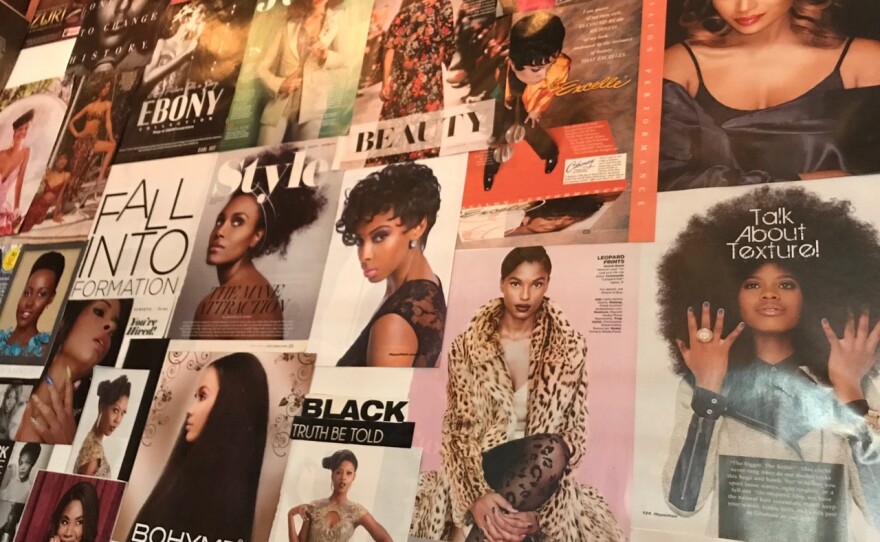In the heart of Denver’s RiNo arts district, Charlie Billingsley has started a new pop-up museum dedicated to an experience rarely highlighted: the Museum for Black Girls.
When she leads visitors through the immersive space, she often starts at Grandma’s Kitchen.
“A lot of our past experiences are with us getting our hair done in either our grandmother, our mother or our auntie’s kitchen — getting ready for church on Sundays or picture days,” Billingsley said.

The brightly wallpapered space features a salon chair. Next to it is a stove with pressing combs and marcel irons on the burners where they would be heated up to either straighten or curl hair.
Billingsley says it’s an almost exact replica of what her grandmother’s kitchen looked like.
The familiar scene showcases the beauty of the Black female experience, as does the exhibit “Roots.” The piece by Colorado Springs artist Aisha Glenn-Bracey features a tree topped with balloons representing a variety of skin tones.
Then there’s the Vibe Affirmation Room — what Billingsley calls a large-scale vision board filled with images of beautiful Black women like Billie Holiday and Pam Grier. There’s also the Iconic Black Women Wall, featuring women like Maya Angelou, Michelle Obama and Corretta Scott King.
“People kind of get lost in this space and stand here for a while trying to point out each and every woman that’s on here,” she said.
The idea for the museum began in 2019, when Billingsley, a photographer, wanted to host an exhibition of her images of Black girls and women. She hoped to inspire her own daughter, Jada, but also wanted a safe space where Black girls and women could truly see themselves.
Following the Black Lives Matter movement and protests last summer, this year’s exhibition has shown that others are also seeing them.
“2020 definitely changed our dynamics,” Billingsley said. “This particular opening has been very different. There have been so many different faces and colors and ethnicities, people coming willing to learn and celebrating with us — even people that are not of color — celebrating with us and loving the space.”

Billingsley partnered on the project with her aunt, LaVonya Washington, who says too often when something focuses on Black women, it revolves around trauma. Washington says it’s important to also show joy and beauty.
“When you think about it, you look at the history and the struggles — we know that’s there — but in this space we want to remember the past, we want to acknowledge the present, and we want to inspire people for what they can be and what they can do in the future,” she said.
One of Washington’s favorite works is an oil painting of a little girl in a field carrying a basket of kittens. While the subject might seem fairly commonplace, it’s actually quite rare.
Washington purchased it 30 years ago, and she still remembers talking with the painter about it.
“He said he had never seen a picture of a Black girl just being in a field of flowers and being sympathetic and caring,” she said. “He said he was in the South and he saw a young lady walking in a field and he was thinking how beautiful she was. He said, ‘I’ve never seen this depicted.’”
Taking back the beauty in the Black experience is a major part of the museum. It’s why things like the Blue Magic room, dedicated to the Black hair care product, connect so intimately with its audience.
“Anything about our hair — if you’re a Black woman — is viewed as a negative thing,” Washington said.
Even the style in which it’s worn. Last year, a new law, called the Crown Act, was passed in Colorado, banning discrimination based on hair styles.

“It’s just crazy that a law had to be passed to say, ‘That’s OK, how you wear your hair is OK,’” she said.
Blillingsley hopes to eventually take the museum on a cross-country tour, so that other Black girls can revel in a place that celebrates the skin they’re in.
“I love to see the little girls come in here, they’re like ‘That looks like me!’” she said. “And I’m like, ‘Yes, that looks like you and that can be you, and you can be OK just how you are and you’re beautiful just the way you are. And look at these beautiful women being just who they are doing amazing things. Not taking a no for an answer. Not changing for anyone. Standing in their own, taking their power back, creating their own seats at the table, creating their own tables.
“If anyone is ever wondering, this is why these spaces are created and this is why these spaces are needed,” Billingsley added. “It’s intimidating to walk into spaces where we’re the only Black girl and we’re like, ‘Do I even belong here?’ That’s what people don’t see.”
The will be open through late April, although Billingsley says she hopes to extend the run date.







